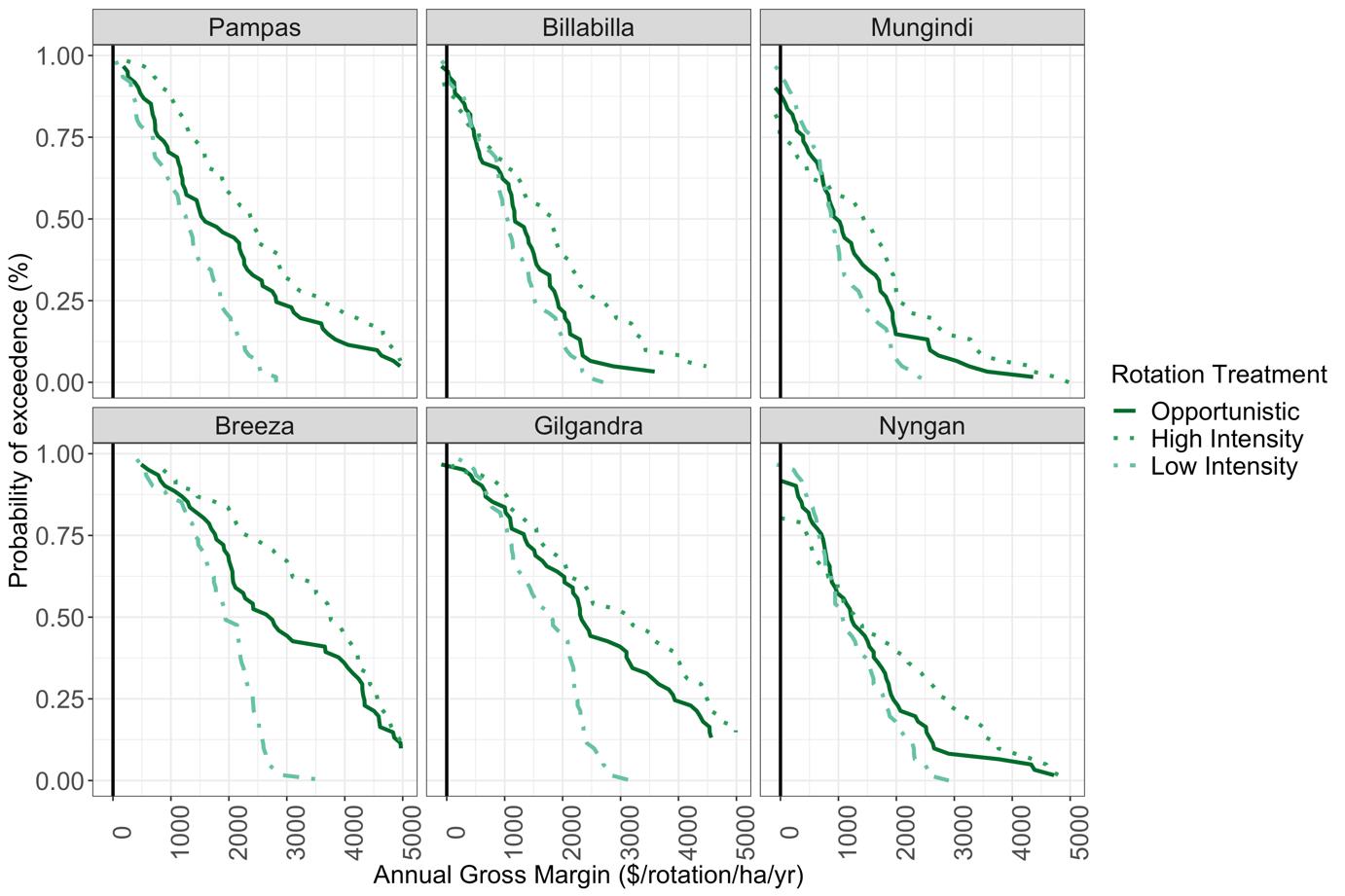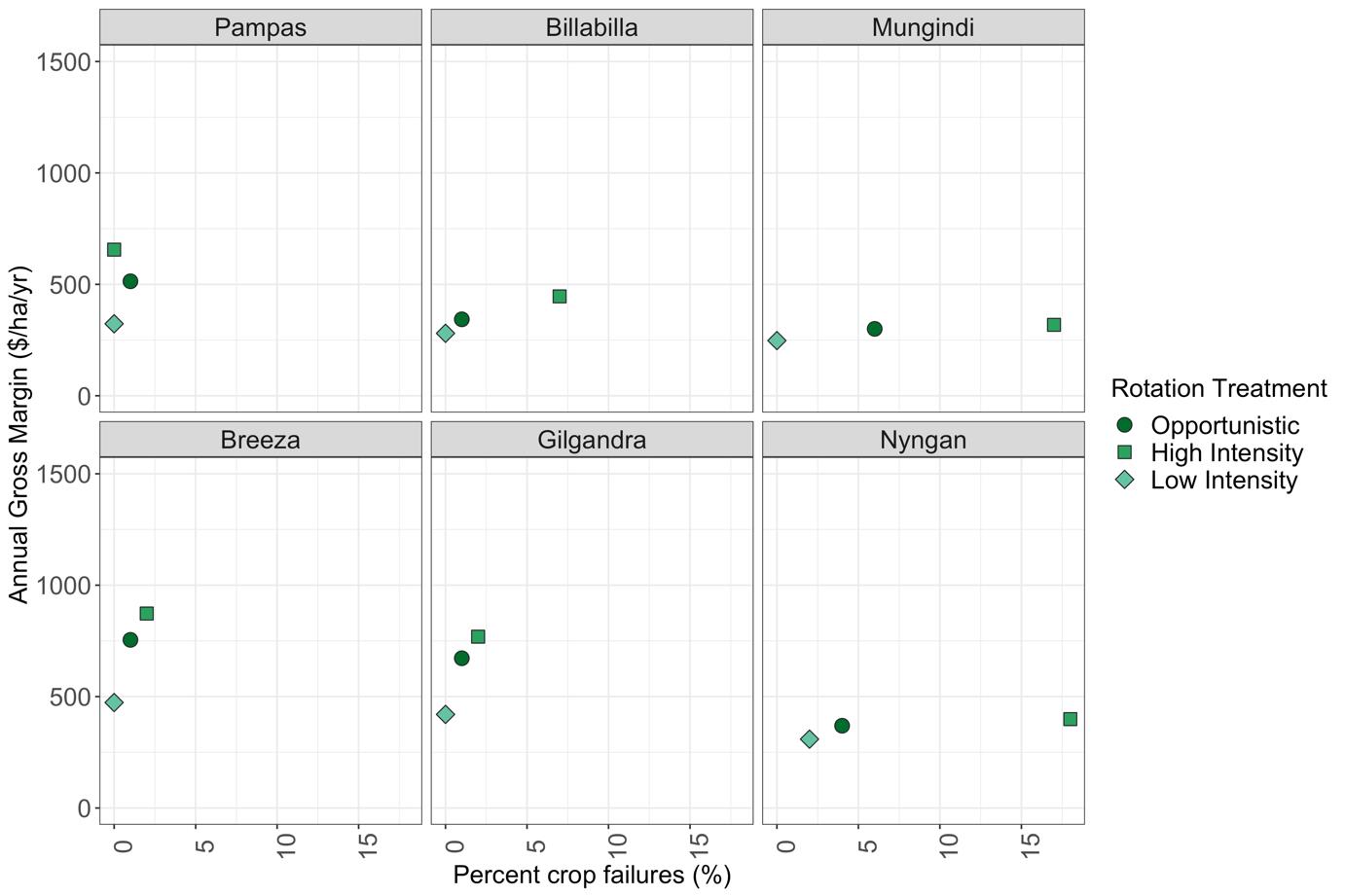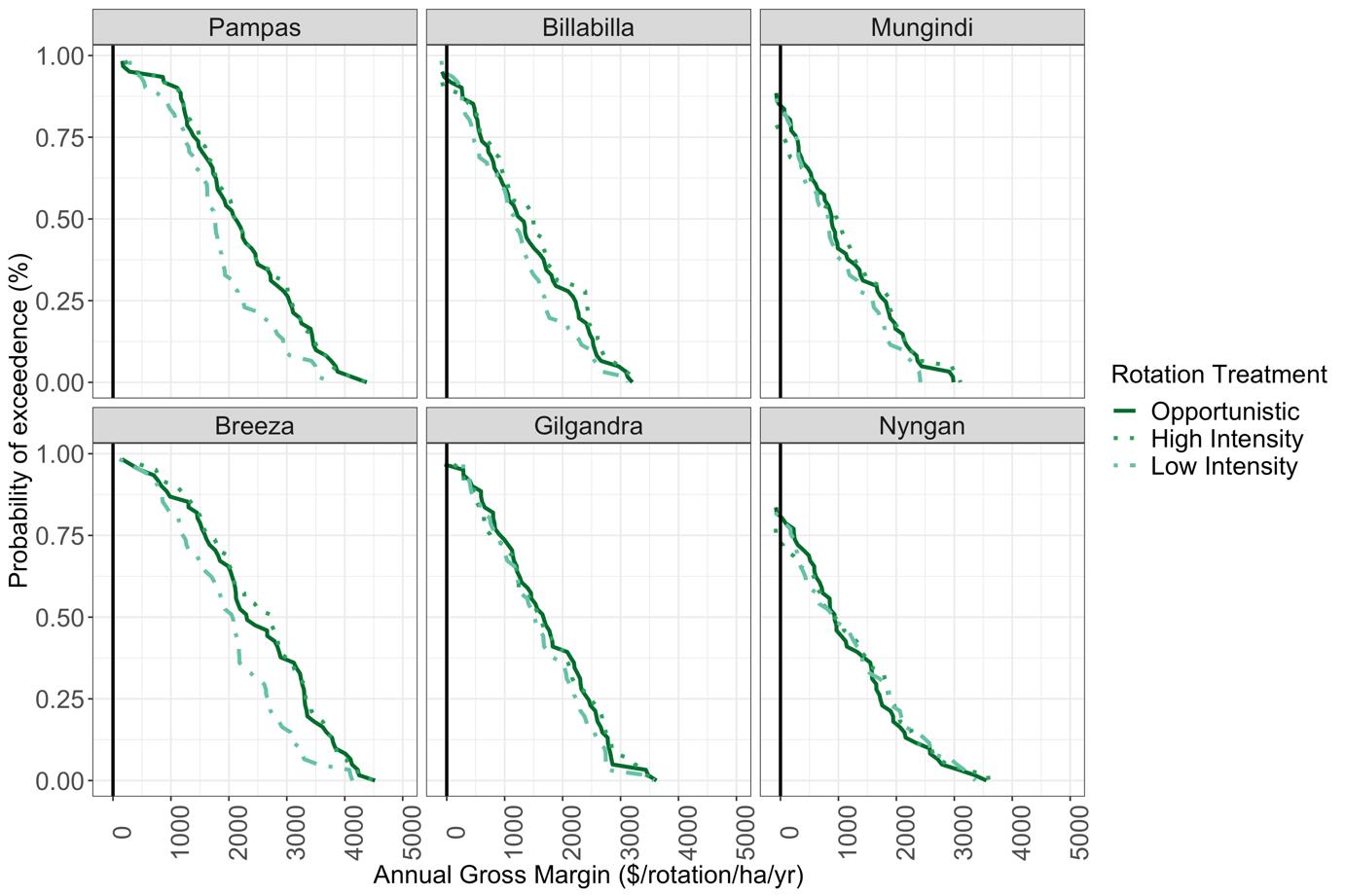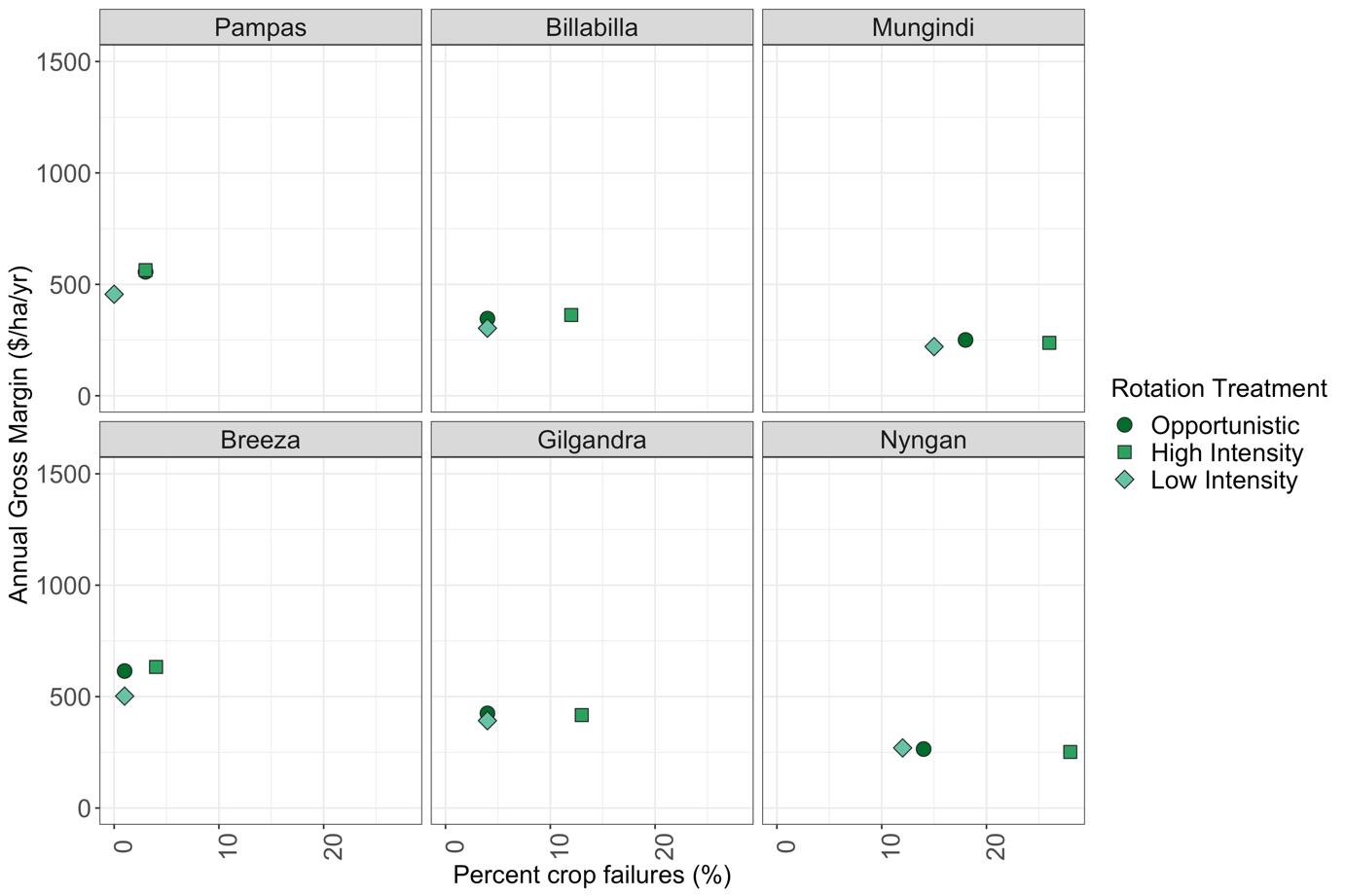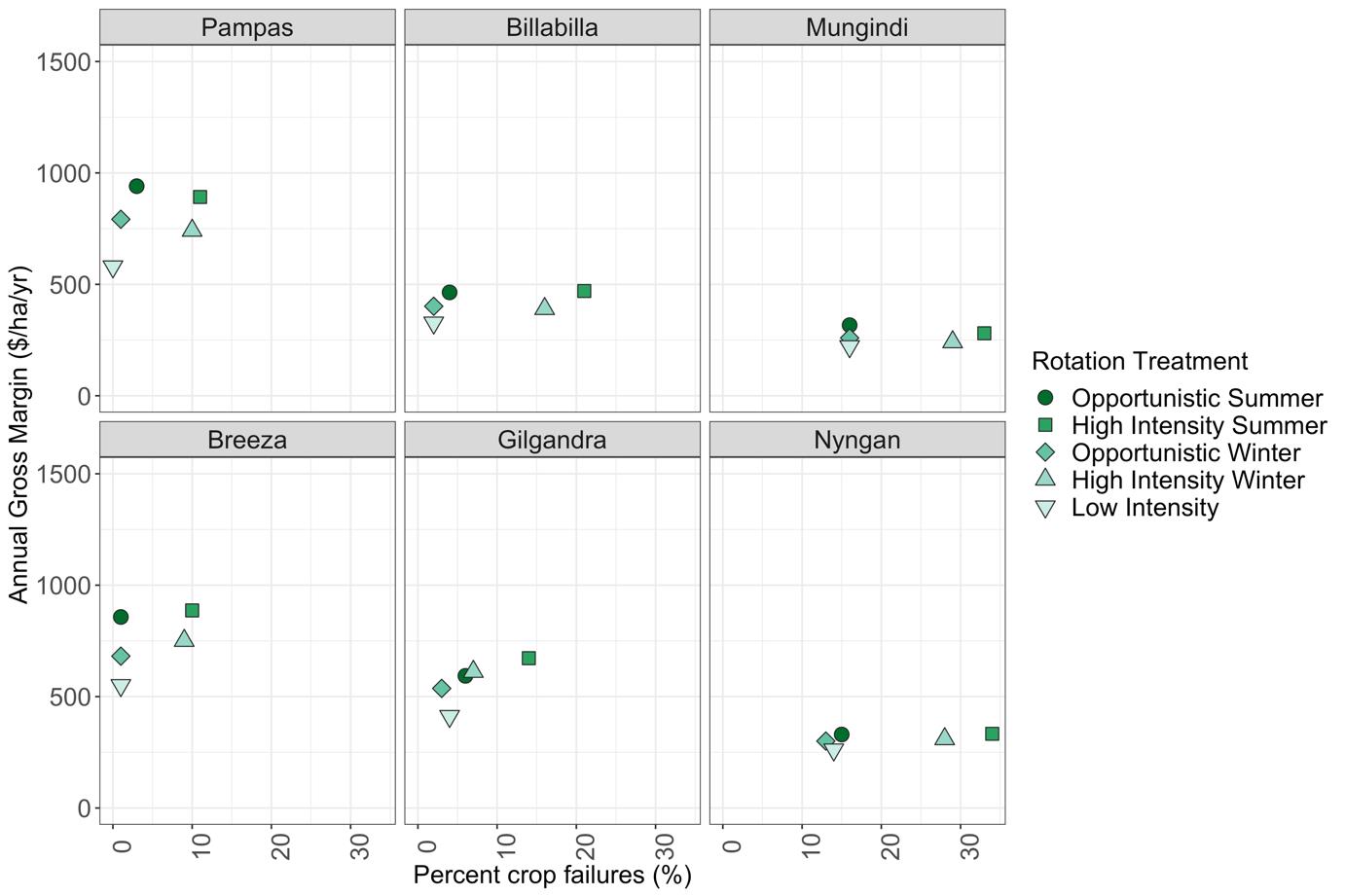Tactical decisions on crop sequencing - opt in/opt out decisions based on plant available water (PAW) triggers
Author: Jeremy Whish (CSIRO Agriculture and Food), Lindsay Bell (CSIRO Agriculture and Food) and Peter DeVoil (QAAFI, University of Queensland) | Date: 26 Feb 2019
Take home messages
- Planting an opportunistic crop to reduce fallow lengths can improve economic returns if strict rules are followed
- Increasing the intensity of a rotation beyond the environmental potential of the area reduces the returns across the whole rotation.
- Planting on less than 100mm of stored soil water in eastern environments and less than 150 mm in western environments significantly increases the probability of failed (negative gross margin) crops.
Introduction
This paper reports on some of the work conducted as part of GRDC’s northern farming systems project. One of the goals of this project is to use both experimental research and simulation modelling to understand the benefits and trade-offs associated with different crop rotations across the northern grains region. For this paper we will use the term rotation to mean a sequence of crops and fallows that regularly follow each other in a cyclic pattern. We are aware that not all grain growers follow a structured fixed rotation and we are not advocating this approach. However, by examining rotations in this structured way, key features (benefits and costs) of the sequence can be observed.
Long fallows are a feature of northern grain production and are mainly used to move between summer and winter phases and/or in more marginal areas to accumulate water to reduce the risk of crop failure. However, there are times when the crop sequence could be intensified by replacing a long fallow with a double crop to move between summer and winter phases or incorporate an additional wheat crop that reduces a long fallow to a short fallow.
Our previous modelling analyses have shown that time in fallow/crop are key drivers of system water use efficiency, profitability and risk. In most production environments, cropping sequences with higher intensity (i.e. more time in crop) have higher average returns over the long-term however this comes with increased risk (frequency of crops with negative gross margins). However, our previous analysis only considered strict rotations where all crops were sown irrespective of soil water conditions and hence, crops are frequently sown on marginal soil water levels in higher intensity systems. Hence, the question we have examined here is how much can risk be mitigated by only taking opportunities to sow double crops in the rotation when soil water triggers are met. We have tested some opportunistic rules to try and identify when to plant an opportunity crop and what effect it has on the overall rotation. In particular we aim to identify where, when and how the rotation can be intensified to increase profitability without significantly increasing production risk, and what triggers to use to make these decisions. This analysis will help guide answers to the questions:
- What soil water do I need to put that additional opportunity crop in?
- What affect will it have on the rest of the rotation and subsequent crops?
- Is it worth the additional risk?
Methods
Simulations
This study is a simulation analysis that uses the APSIM systems framework (Holzworth et al., 2015) to simulate crop rotations from historic climate records (1957-2017). APSIM has a long history of simulating northern farming systems (Carberry et al., 2009; Whish et al., 2007) and uses environmental signals to trigger appropriate management decisions. However, these simulations only consider the dynamics of water and nutrients. Losses due to waterlogging, heat or frost shock events, disease, pests, weeds or crop nutrition other than nitrogen were not considered by these simulations.
The simulations of all crop sequences were phased, so that each year of the rotation was exposed to each year of the climate record (1956-2016). All rotations were run at each of 6 sites (Table 1) to highlight the importance of matching crop choice and intensity to the environmental conditions. The sites were selected to represent an east-west rainfall gradient at both a northern (Pampas – Billabilla – Mungindi) and southern latitude (Breeza – Gilgandra – Nyngan). Each site used a locally representative soil among the higher plant available water capacity (PAWC) in each district (Table 1).
Table 1. Soil details used in simulations at the 6 locations across the northern grains region
Location | Soil description | APSoil No. | Soil plant available water capacity (PAWC) (mm) | Annual rain | |||
|---|---|---|---|---|---|---|---|
Wheat | Sorghum | Chickpea | Mungbean | (mm) | |||
Pampas | Black vertosol | 006 | 290 | 234 | 290 | 211 | 698 |
Billabilla | Grey vertosol | 220 | 188 | 188 | 167 | 140 | 619 |
Mungindi | Grey vertosol | 157 | 186 | 201 | 186 | 141 | 505 |
Breeza | Black vertosol | 123 | 264 | 273 | 210 | 207 | 680 |
Gilgandra | Clay loam | 249 | 195 | 195 | 195 | 89 | 560 |
Nyngan | Sandy clay | 1162 | 188 | 188 | 188 | 108 | 445 |
Rotations
This analysis is designed to look in detail at increasing intensity both in a fixed pattern and using opportunistic crop inclusion. A set of three base crop sequences were simulated each with a low and a high crop intensity, with varying lengths of fallows and time in crop (Table 2). The three sequences were chosen to span different cropping intensities that will match different production environments simulated. In these base rotations (high and low intensity) the crops in the sequence were sown every year (must sow crops) in a fixed pattern within their sowing window (Table 2). If the sowing rule had not been met by the end of the sowing window then the crop was sown at this time. In contrast to these higher and lower intensity systems an opportunistic sequence was simulated where a crop was either sown or remained in fallow based if the soil water did not reach the critical threshold during the sowing window (Table 3). Simulations were also conducted with two levels of soil water thresholds required to trigger a planting event (base – higher PAW at sowing, and aggressive – lower PAW at sowing) (Table 3). To ensure that the rotations did not get out of sequence and could be phased, specific parts of the rotation were fixed so these crops were sown every year despite the rules.
Table 2. Description of low and high intensity rotations where all crops are sown every year and opportunistic crop rotation where some crops are only grown when soil water exceeds a minimum threshold (shown in grey with an underline).
Rotation Intensity | Winter | Balanced - conservative | Balanced - aggressive | |||
|---|---|---|---|---|---|---|
Crops | /yr | Crops | /yr | Crops | /yr | |
Low | xW|xx|xCh|xx | 0.5 | Sx|xCh|xW|xx | 0.75 | SCh|xW|xx | 1.0 |
High | xW|xW|xCh|xW | 1.0 | Sx|xCh|xW|Mgx | 1.0 | SCh|xW|Mgx | 1.33 |
Opportunistic | xW|xW|xCh|xW | 0.5-1.0 | Sx|xCh|xW|Mgx | 0.75-1.0 | SCh|xW|Mgx SCh|xW|xx | 0.66-1.33 0.5-1.0 |
W= wheat, Ch = chickpea, Mg = mungbean, x= 6 month fallow.
Table 3. Summary of key management rules to trigger sowing, and crop agronomic management rules applied to crops across the set of simulations
Crop | Sowing window | Minimum planting soil water (mm) | APSIM Variety used | Row spacing (cm) | Plant density (#/m2) | Starter fertiliser (N kg/ha) | |
|---|---|---|---|---|---|---|---|
Base | Agg. | ||||||
Wheat | 15 May-1 Jul | 150 | 100 | Gregory | 25 | 100 | 25 |
Chickpea | 1 May-1 Jul | 150 | 100 | Amethyst | 50 | 30 | 0 |
Sorghum | 15 Oct – 15 Jan | 150 | 100 | Buster | 100 | 7 | 25 |
Mungbean (spring) | 15 Oct-15 Nov | 100 | 60 | Green Diamond | 50 | 30 | 0 |
Mungbean (double crop) | 15 Nov – 15 Jan | 100 | 60 | ||||
Economic analysis parameters
Average annual gross margin (GM) analysis was conducted for each phased crop sequence using the equation below. Long-term average grain prices (2008-2017) and current variable input prices were used and these were held constant across all locations. Insurance and levy costs together were 2% of the grain income value and were deducted from grain prices. The price for nitrogen (N) fertiliser applied was set at $1.30/kg N and each fallow spray was set at $17/ha. The simulations did not account for application losses of N fertilisers; therefore, an additional 30% of applied N was used to ensure fertiliser N reached the soil mineral N pool. The baseline “variable cost” for each crop included planting, non-N nutrients and in-crop pesticide applications. Harvesting costs, N fertiliser and fallow spray frequency were included separately, as these varied between the crop sequences or if crops failed. Crops were considered as failed if the yield was less than the thresholds (Table 4) and harvesting costs were not included. Machinery costs were based on an owner-operated production system; therefore, fuel, oil, repairs and maintenance (FORM) costs where included in variable costs.
Table 4. Crop prices and variable costs used in gross margin calculations for crop sequences
Crop | Average price | Harvest cost | Variable costs | Failed crop threshold |
|---|---|---|---|---|
Wheat | 264 | 40 | 175 | 500 |
Sorghum | 225 | 55 | 218 | 800 |
Chickpea | 569 | 45 | 284 | 340 |
Mungbean | 710 | 55 | 276 | 300 |
#farm gate price with grading & additional harvesting costs already deducted
Results
There are a large range of combinations of crop sequence by locations that were generated in this analysis. Only a selection of the most illustrative results will be presented to highlight how the different options behave in the different environments.
Winter crop sequence
The conservative low intensity rotation (xW|xx|xCh|xx) is commonly used in more marginal western sites and has been previously shown to be effective for minimising risk in such environments. A large gap exists between the low intensity rotation (xW|xx|xCh|xx) and the more intensive sequence (xW|xW|xCh|xW) when sown at Pampas, Breeza, Billabilla or Gilgandra because these environments are too reliable for such a conservative strategy and can support a more intensive crop rotation. However, at Nyngan and Mungindi about 50% of the time each of the high and low intensity sequences are the best – the higher intensity in better seasons and the lower intensity in poorer years (Figure 1). This analysis shows by employing an opportunistic strategy fills the gap between the conservative and the high intensity strategy to capitalise on the good seasons and remain conservative in poorer seasons.
Figure 1. Comparison of the three winter-based crop rotations of low intensity (dot dash), high intensity (dot dot), and with opportunistic crop decisions (solid) at each of the six sites examining their probability of exceeding an annual gross margin. The solid black line marks the zero gross margin point with negative gross margins occurring to the left of this line.
Increasing risk is associated with increasing intensity and the risk of a producing a negative gross margin is one way to assess this risk (Figure 2). The environments of Pampas, Breeza, Billabilla and Gilgandra have few failed crops - less than 1 crop in 20 did not break-even. However, in the more marginal areas imposing a rotation that has an intensity of 1 crop per year (xW|xW|xCh|xW) resulted in over 15% of crops failing. Using the opportunistic rule, the average gross margin was similar to this more intensive system, but the risk was significantly reduced to around 1 crop in 20 failing.
Figure 2. Mean annual gross margin compared to the percentage of failed crops for winter-based rotations of low intensity (Dimond), high intensity (Square) and using an opportunistic sowing rule (Circle).
Looking more closely at the individual components of the rotation (Table 5) highlights how the opportunistic decision, but more importantly the decision not to sow affects the rotation.
The second and third wheat crops (wheat_2, wheat_3) were the opportunistic crops and were only sown when 150 mm of soil water had accumulated in the sowing window. At Mungindi this meant that only 1 in 4 years would the additional wheat crops be sown. Hence, crop intensity only increases from 0.5 crops per year in the low intensity system to 0.66 crops per year. The average return from these crops sown only when the soil water threshold was met was more than twice the average return from crops that were sown every year and all crops broke even at least. The returns from the scheduled wheat crop 1 and chickpea crop 1 (sown every 2 years) was also increased significantly ($140-170/ha). This was because when crops are sown on marginal soil water and fail they consume resources that are no longer available to following crops reducing their subsequent yields and gross margin. On average the opportunistic strategy improved returns over the low intensity rotation by more than $50/ha/yr.
Table 5. Individual crop behaviour for each of the conservative rotations conducted at the low rainfall sites of Mungindi and Nyngan for a low and high intensity crop rotation where all crops are sown each year or an opportunistic system where wheat crops may be sown in-between when soil water exceeds 150 mm during the sowing window.
Site | State | Low intensity xW|xx|xCh|xx | High intensity xW|xW|xCh|xW | Opportunistic xW|xW|xCh|xW | ||||||
|---|---|---|---|---|---|---|---|---|---|---|
% | % crops fail | GM ($/ha) | % crops sown | % crops fail | GM ($/ha) | % crops sown | % crops fail | GM ($/ha) | ||
Mungindi | Per year | 0.5 | 247 | 1.0 | 319 | 0.66 |
| 298 | ||
Chickpea_1 | 100 | 5 | 624 | 100 | 21 | 470 | 100 | 10 | 595 | |
Wheat_1 | 100 | 8 | 365 | 100 | 26 | 254 | 100 | 16 | 333 | |
Wheat_2 | 100 | 28 | 253 | 27 | 10 | 430 | ||||
Wheat_3 | 100 | 23 | 296 | 27 | 0 | 448 | ||||
Nyngan | Per year | 0.5 |
| 308 | 1.0 |
| 399 | 0.64 |
| 364 |
Chickpea_1 | 100 | 2 | 713 | 100 | 18 | 513 | 100 | 5 | 688 | |
Wheat_1 | 100 | 3 | 522 | 100 | 21 | 346 | 100 | 8 | 485 | |
Wheat_2 | 100 | 21 | 352 | 33 | 0 | 492 | ||||
Wheat_3 | 100 | 20 | 386 | 33 | 0 | 608 | ||||
Balanced - conservative
The balanced- conservative rotation is designed to have both summer and winter phases (Sx|xCh|xW|xx), which was intensified through the the use of either a scheduled (sown every year) or opportunistic mungbean crop (Sx|xCh|xW|Mgx) to move between the winter and summer phase. At most locations the inclusion of mungbeans opportunistically matched the returns of the high intensity strategy where they were sown every year for majority of the seasons. A few occurrences occurred around the average when the opportunistic crop was not sown and subsequently a good season enabled a good yield and return. Pampas and Breeza show a distinct difference between conservative 3 crops in four year rotation (SxxChxWxx) and the higher intensity system which have 1 crop per year (Sx|xCh|xW|Mgx). This suggests that in these environments there is still room for intensification to at least 1 crop per year. The minimal difference between the different rotations at Mungindi and Nyngan suggest this level of intensity is too high for this environment.
Figure 3. Comparison of the three balanced- conservative crop rotations of low intensity (dot dash), high intensity (dot dot), and with opportunistic crop decisions (solid) at each of the six sites examining their probability of exceeding an annual gross margin. The solid black line marks the zero gross margin point with negative gross margins occurring to the left of this line.
The opportunistic use of mungbeans reduced the risk of crops with negative gross margins compared to a crop sequence where these were sown every year. In fact, the risk of crop failures was hardly higher than the low intensity system where mungbeans were not used at all. The examination of the number of failed crops highlights the limitations of the such a crop sequence in the dryer environments of Mungindi and Nyngan.
Figure 4. Mean annual gross margin compared to the percentage of failed crops for balanced conservative rotations of low intensity (Dimond), high intensity (Square) and using an opportunistic sowing rule (Circle). The opportunistic sowing of mungbean achieved a gross margin similar to or better than the high intensity rotation with similar risk to the low intensity rotation.
Examining the components of the rotation (Table 6) highlights the importance of only planting a crop when resources are present to give it the best possible chance of success. The fixed rotation that sowed mungbeans every year had 31% and 49% of crops failing at Billabilla and Gilgandra. In comparison, the opportunistic rotation had 5% and 22% of mungbean crops failing. At the same time the annual gross margin was increased by $60 per ha at Billabilla, but at Gilgandra the high risk of mungbean crops meant that of these sequences the low intensity system was probably a better option based on returns and risk.
Table 6. Individual crop behaviour for each of the balanced rotations conducted at the medium rainfall sites of Billabilla and Gilgandra
site | State | Low intensity Sx|xCh|xW|xx | High intensity Sx|xCh|xW|Mgx | Opportunistic Sx|xCh|xW|Mgx | ||||||
|---|---|---|---|---|---|---|---|---|---|---|
% | % crops fail | GM ($/ha) | % crops sown | % crops fail | GM ($/ha) | % crops sown | % crops fail | GM ($/ha) | ||
Billabilla | Per year | 0.75 | 409 | 1.0 | 489 | 0.85 |
| 463 | ||
Chickpea_1 | 100 | 4 | 753 | 100 | 4 | 755 | 100 | 7 | 759 | |
Mungbean_1 | 100 | 31 | 264 | 40 | 5 | 517 | ||||
Sorghum_1 | 100 | 7 | 539 | 100 | 11 | 581 | 100 | 4 | 554 | |
Wheat_1 | 100 | 9 | 345 | 100 | 9 | 357 | 100 | 9 | 349 | |
Gilgandra | Per year | 0.75 |
| 527 | 1.0 |
| 561 | 0.85 |
| 517 |
Chickpea_1 | 100 | 0 | 999 | 100 | 0 | 1028 | 100 | 0 | 1014 | |
Mungbean_1 | 100 | 49 | 5 | 40 | 22 | 247 | ||||
Sorghum_1 | 100 | 16 | 414 | 100 | 2 | 517 | 100 | 11 | 470 | |
Wheat_1 | 100 | 2 | 697 | 100 | 2 | 696 | 100 | 2 | 703 | |
Balanced - aggressive
The intense rotations tested here were examined to see how much there is capacity to capitalise on the higher rainfall conditions in more eastern environments of Breeza and Pampas. In these sequences two options for intensifying the farming system involving a chickpea double crop sown either every year or opportunistically following sorghum (SCh|xW|xx) and further intensifying the system with a mungbean double crop sown either every year or opportunistically following wheat (SCh|xW|Mgx). These three different options provide a wide range of crop intensities to emerge in response to the environment ranging from 2 crops in 3years (0.66 crops/yr) to 4 crops in 3 years (1.3 crops per yr). The data falls into 2 clumps, but the key message is that in the eastern environments of Pampas and Breeza the opportunistic rotations matched the fixed rotations in terms of gross margin for the majority of seasons with little difference between the opportunistic and the intense (Figure 5) apart from risk (Figure 6).
Figure 5. Comparison of the balanced- aggressive crop rotations of low intensity (light grey dash), high intensity (dot dot), and with opportunistic crop decisions (solid). The summer opportunity rotations are dark and the winter rotations are grey. The solid black line marks the zero gross margin point with negative gross margins occurring to the left of this line.
Figure 6. Mean annual gross margin compared to the percentage of failed crops for balanced-aggressive rotations of low intensity (downward triangle), high intensity summer(square), high intensity winter (upward triangle), using an opportunistic sowing rule for summer (circle) and using an opportunistic sowing rule for winter (diamond). The opportunistic sowing of mungbean and chickpea reduce the fallow length and achieved a high gross margin with minimal risk when sown in the eastern environments of Pampas and Breeza
The use of the opportunistic planting rules significantly reduced the number of crops producing a negative gross margin, while increasing the average returns from each of the individual crops. For example, by only sowing the chickpea double crop after sorghum when 150 mm of soil water was present, this reduced the frequency of crop failures from 21 at Breeza and 31% at Pampas to 0 and 3% respectively. This also increased the average gross margin for these crops by over $500/ha, though crops were only sown 1 in 3 years at Breeza and 2 in 3 years at Pampas. A similar story was also true for the opportunistic incorporation of mungbeans into the cropping system. Overall, utilising an opportunistic approach to double-crops of chickpea and mungbeans in these environments was predicted to achieve equal or higher overall average annual returns and dramatically reduced risk compared to a scheduled approach. (Table 7).
Table 7. Individual crop behaviour for each of the intense rotations conducted at the high rainfall sites of Pampas and Breeza
Site | State | Low intensity Sx|xW|xx | Moderate intensity SCh|xW|xx | Opportunistic - mod SCh|xW|xx | High intensity SCh|xW|Mgx | Opportunistic - high SCh|xW|Mgx | ||||||||||
|---|---|---|---|---|---|---|---|---|---|---|---|---|---|---|---|---|
% crops sown | % crops fail | GM ($/ha) | % crops sown | % crops fail | GM ($/ha) | % crops sown | % crops fail | GM ($/ha) | % crops sown | % crops fail | GM ($/ha) | % crops sown | % crops fail | GM ($/ha) | ||
Breeza | Per yr | 0.66 | 542 | 1.0 | 755 | 0.77 |
| 715 | 1.35 |
| 910 | 0.98 |
| 904 | ||
Chickpea_1 | 100 | 21 | 560 | 32 | 0 | 1087 | 100 | 21 | 535 | 26 | 0 | 1182 | ||||
Mungbean_1 | 100 | 20 | 505 | 68 | 0 | 718 | ||||||||||
Sorghum_1 | 100 | 3 | 755 | 100 | 3 | 815 | 100 | 3 | 791 | 100 | 3 | 772 | 100 | 2 | 804 | |
Wheat_1 | 100 | 0 | 889 | 100 | 3 | 890 | 100 | 2 | 909 | 100 | 2 | 884 | 100 | 2 | 987 | |
Pampas | Per yr | 0.66 | 0 | 579 | 1.0 |
| 748 | 0.87 |
| 798 | 1.35 |
| 912 | 1.12 |
| 956 |
Chickpea_1 | 100 | 32 | 364 | 60 | 3 | 913 | 100 | 33 | 320 | 49 | 3 | 922 | ||||
Mungbean_1 | 100 | 10 | 637 | 85 | 11 | 668 | ||||||||||
Sorghum_1 | 100 | 0 | 1144 | 100 | 0 | 1221 | 100 | 0 | 1186 | 100 | 2 | 1089 | 100 | 0 | 1134 | |
Wheat_1 | 100 | 0 | 613 | 100 | 0 | 659 | 100 | 0 | 654 | 100 | 0 | 657 | 100 | 0 | 692 | |
Conclusions
This paper has demonstrated that opportunistic sowing rules can be employed to increase the intensity of the farming system and increase returns relative to low intensity conservative approaches at the same time as managing risk. All the results presented above used the base sowing rules of 150mm of stored water at sowing for all crops apart from mungbean that used 100mm. Further analysis comparing these rather high soil water thresholds with lower and more aggressive soil water thresholds (100mm for all crops and 60mm for mungbeans) was also conduced but not presented here to save space. In summary reducing the soil water trigger made no impact on the results at Breeza and Pampas. However, using lower soil water threshlds increased risk of crop failures by a few percent at Billabilla and Gilgandra, but was increased this considerably at Mungindi and Nyngan.
This work shows there are considerable benefits of opting out of a crop if the conditions are not favourable or opting in to crops opportunistically based on soil water triggers. The rules presented are robust when run over a 60 year period and show the carryover effect of a failed crop can reduce the returns of those crops that follow. However, it is always easier to not plant a crop while sitting on a computer and not looking at a pile of expensive seed in the shed. This is a difficult decision but knowing how much water you have in the soil and how forgiving your environment is can help answer the question should I opt in or opt out.
References
Carberry, P.S., Hochman, Z., Hunt, J.R., Dalgliesh, N., McCown, R.L., Whish, J.P.M., Robertson, M.J., Foale, M., Poulton, P.L. and van Rees, H., (2009) Re-inventing model-based decision support with Australian dryland farmers. 3. Relevance of APSIM to commercial crops. Crop Pasture Sci. 60, 1044–1056. doi:10.1071/CP09052
Holzworth, D.P., Snow, V.O., Janssen, S., Athanasiadis, I.N., Donatelli, M., Hoogenboom, G., White, J.W. and Thorburn, P., (2015) Agricultural production systems modelling and software: Current status and future prospects. Environmental Modelling & Software 72, 276–286. doi:10.1016/j.envsoft .2014.12.013
Whish, J.P.M., Castor, P.A. and Carberry, P.S., (2007) Managing production constraints to the reliability of chickpea (Cicer arietinum L.) within marginal areas of the northern grains region of Australia. Crop Pasture Sci. 58, 396–405. doi:10.1071 /AR06179
Whish, J.P.M., Price, L., Castor, P.A., 2009. Do spring cover crops rob water and so reduce wheat yields in the northern grain zone of eastern Australia? Crop Pasture Sci. 60, 517–525. doi:10.1071/CP08397
Acknowledgements
The research undertaken as part of this project is made possible by the significant contributions of growers through both trial cooperation and the support of the GRDC, the author would like to thank them for their continued support.
Contact details
Jeremy Whish
CSIRO Agriculture and Food
Ph: 07 4571 3215
Email: jeremy.whish@csiro.au
Varieties displaying this symbol beside them are protected under the Plant Breeders Rights Act 1994.
GRDC code: CSA00050
GRDC Project Code: CSP1406-007RTX,
Was this page helpful?
YOUR FEEDBACK

